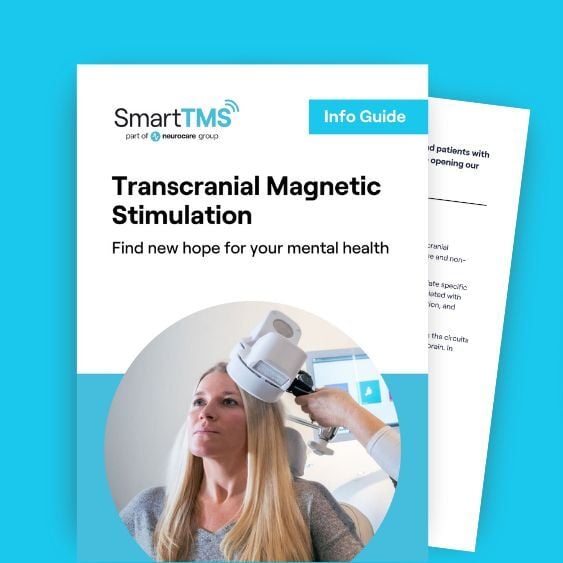All About Anxiety & How To Manage Your Symptoms – Smart TMS
February 17, 2020 - Smart TMS

Everyone feels anxious from time to time. In fact, feeling anxious can be our brain’s way of protecting us. But what happens when inexplicable anxiety becomes uncontrollable and takes over your life?
What is Anxiety?
Anxiety is a feeling of worry, fear or apprehension and usually occurs before or during a particularly stressful time. When our brains feel as though they’re under threat, our bodies are ordered to release hormones like adrenaline in response. These hormones can impact both our thoughts and our physical responses.
Fight, Flight, Freeze
The flight, flight or freeze response can be understood by imagining you’ve come face to face with a tiger. Our brain knows that the tiger wants to eat us, so it might respond in a number of ways:
- Fight – Your brain may instruct you to fight the tiger in attempt to defend yourself. Your heart rate and your strength may increase and you’ll become super-aware of your surroundings, ready to protect yourself;
- Flight – Your brain might instruct you to run away from the tiger. Your heart will pump more blood to your legs to help you run faster and you’ll try to get more oxygen into your lungs to allow you to keep running to safety;
- Freeze – This can be the trickiest response to understand, after all, why would we want to stand still in front of a hungry tiger?! Not only might you freeze to assess whether the tiger is a danger to you, your “primitive brain” may take over and immobilise you entirely. This is very similar to an animal “playing dead” and works by hoping the tiger will lose interest and move on to their next snack.
Over the years, experts have identified additional Fs to describe fear responses. These include: flooding (being overcome with emotion), fawning (or submitting to the tiger) and fatigue (sleeping to get through the crisis).
But, There’s No Wild Tigers Here!
Despite what Judith Kerr would have us believe, tigers don’t commonly turn up for tea. Anxiety responses don’t only come into play when we’re faced with a wild predator, however. Anxiety can be triggered by day to day events.
For example, if your boss called you into their office for an unexpected chat, only to tell you that your performance isn’t as they’d expect it to be, your brain may sense a threat. Although it’s not a physical threat, you’ll likely be concerned about losing your job, not having an income, paying your mortgage and so on. So, do you fight by confronting your boss, flee by removing yourself from the situation or freeze, whilst feeling unable to formulate an immediate response to your boss’ claims?
When Does Anxiety Become A Problem?
Anxiety becomes a problem when your brain begins telling your body to respond to every day situations as if they’re threats. Your fears and worries might become out of proportion to the situation you’re in, resulting in you avoiding situations all together. This can be extremely distressing. As much as you rationally know that the “anxiety tiger” isn’t in your local supermarket, it may as well be if you’re experiencing physical and emotional symptoms of anxiety.
How Can We Reduce Anxiety?
Smart TMS : Holborn based practitioner, Dr Pegah Shojaii, gives us some ideas to help reduce the symptoms of anxiety. She suggests;
“When you’re in the throes of anxiety, someone telling you to breathe can seem useless but there really is merit behind focusing on your breathing! The mobile app “Breathe2Relax” (available on Android and Apple) asks you to rate how you’re feeling on a scale of relaxed to stressed. The app then tailors your controlled breathing to your levels of stress. It takes you through a mindfulness exercise, with the aim of reducing your anxiety once you’re already feeling overwhelmed.”
Pegah also describes how “pink noise” can reduce anxieties;
“According to research conducted in 2017 (Gould van Praag), believes that pink noise increases the resting activity in your brain helping you to concentrate. Pink noise sounds like waves rather than the hiss or buzz of white noise. It increases in volume as the frequency decreases and vice versa, just like waves crashing on the shore. Some people find white noise to be more irritating than relaxing, and pink noise could be the solution to this.”
Treatment for Anxiety
Typically, a GP would prescribe talking therapies like Cognitive Behavioural Therapy (CBT) in the first instance. Anti-anxiety medication such as Benzodiazapines and anti-depressants might be prescribed to reduce the symptoms of anxiety on a day to day basis, too.
Repetitive Transcranial Magnetic Stimulation, or rTMS, is a relatively new treatment for anxiety. However, it sees over 80% of patients experience a reduction in their levels of anxiety within 6 weeks (on average). From our own research at Smart TMS, we recognise that anxiety and depression often work hand in hand. For this reason, we treat both conditions simultaneously.
To learn more about how Smart TMS can improve your anxiety, contact us today:
Tel: 0345 222 5678
Email: info@smarttms.co.uk










